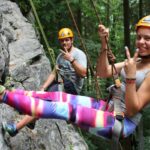5 things about climbing I wish I knew 5 years ago: We’ve all had that moment in climbing where something finally clicks, either physically or mentally. For most of us, that moment came later in our climbing career – followed by that temporary moment of regret: ‘If only I’d known this when I first started climbing!’ Today Sarah Williams shares her list of 5 things she wishes she’d known when she started climbing 5 years ago. While it might be too late for some of us, hopefully, Sarah’s advice will inspire any newbies just getting into the sport!
You must know about one of the common problems in climbing, check it out!
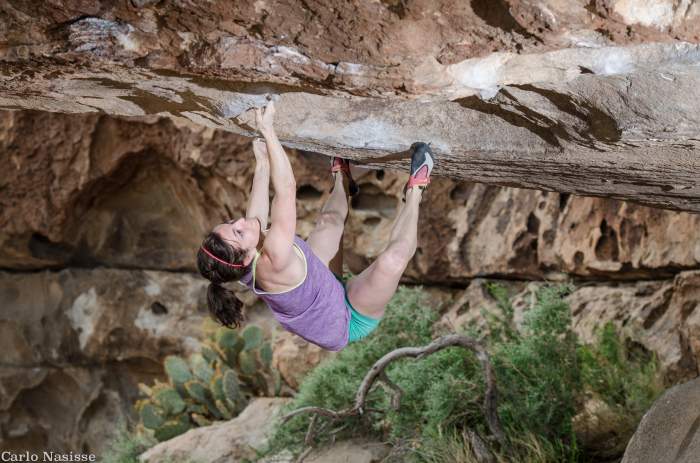
Sarah Williams putting her climbing lessons learned into practice. (Photo credit: Carlo Nasisse)
5 Things About Climbing I Wish I Knew 5 Years Ago
Climbing Lesson #1: Try Harder Stuff
Any gym rat can tell you that grades are very subjective. You may be cruising V5’s but just can’t seem to pull the move on one funky V3, or you might put 15 attempts into a V6 and flash the V7 next to it. Just because you’re climbing V3 and projecting V4 doesn’t mean you can’t jump on a V5 or even harder.

Sarah working (and falling) on the first long move of a pumpy V8 (Photo credit: Jeline Guiles)
To some people this is naturally obvious, as evidenced by that guy who is struggling on V2 but sees a girl climb a V7, and immediately feels empowered to give it a try (even if he sits there falling on the first move for a good 15 minutes). But others, like my younger self, are quite a bit more timid. I rarely tried grades above my limit for fear of being that guy who repeatedly falls on the first move of a climb.
But, if we never try hard, we’ll never improve. Sasha Diguilian wrote a really great article on this awhile ago. Getting on hard climbs helps us to learn the movements that we need to master in order to climb harder.
Example–I used to rarely climb roofs because I knew that I was horrible at them. But as I got better at vertical climbing and timidly, occasionally attempted a roof climb even 2 grades below my max, I often fell. By not practicing the movement needed to send roof climbs I was limiting my own ability. This brings me to another point…Try, Try Again.
Climbing Lesson #2: The 7 Try Rule
As I started to realize how much my fear of failing was impacting my climbing I came up with the 7 try rule. It’s pretty simple: if you fall on a climb, you have to try that move 7 times before you can walk away from the problem. So, you walk up to a boulder problem around your level. The first move is a throw to a sloper. You get on the holds, set up, go…..and splat, you’re back on the ground.
You think to yourself: “Well, that’s a weird movie, and it’s a really bad sloper, and I’m too short to make that long of a move, and I don’t like dynamic climbs–I’m a static climber so I’m just going to try something else.”

Now try the far toe hook on try #2. (Photo credit: Jeline Guiles)
Don’t make this mistake! Try it six more times. More often than not you will surprise yourself with how much progress you can make if you just commit to working out the move 7 times. Cruxy moves often involve a learned body movement, and trying it just once won’t suffice. By walking away from climbs that don’t seem to be your style at first glance you’ll severely limit yourself, and the skill gap between your strengths and weaknesses will grow even wider.
No one is naturally great at every style of climbing; whatever your weakness is–pinches, dynos, slopers–you have to continually practice those movements to get better.
So what are you thinking about or working on during those 7 tries?
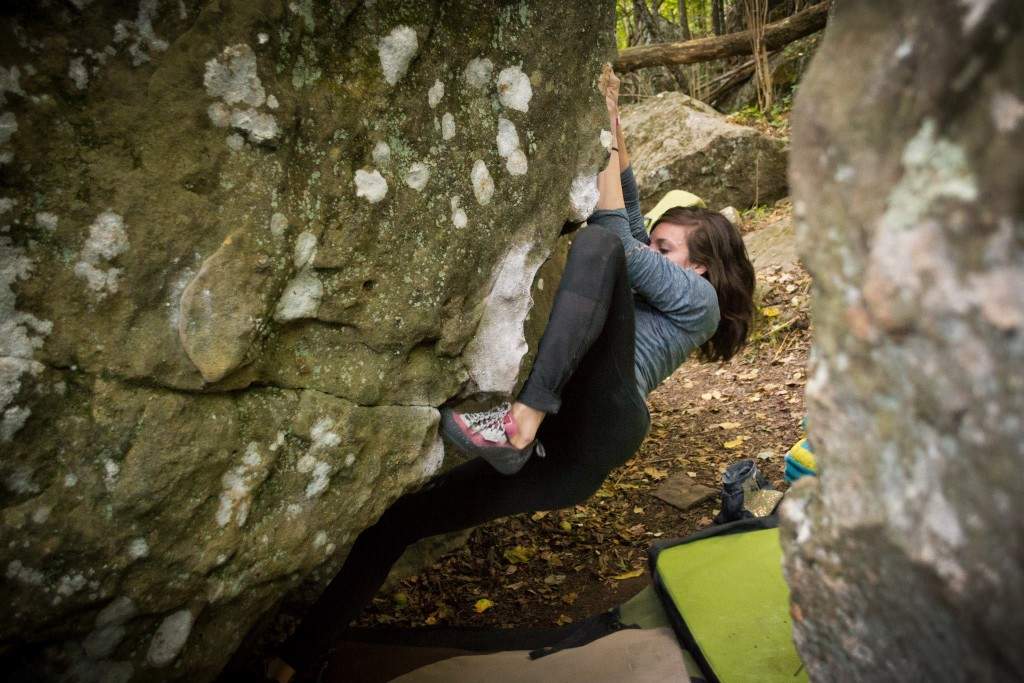
And now the close toe on try #… (Photo credit: Jeline Guiles)
Climbing Lesson #3: Focus on the Movement
About 2 years ago I was trying to stick an aaallllmost deadpoint, where my foot kept popping. My boyfriend (who was also a climbing coach at the time) told me to try the move while thinking about my left foot. My first instinct: “What does that mean? What am I supposed to think about my foot? Its location? The stylish climbing shoes I’m wearing?” But nonetheless, I tried the move while realllllly focusing on pushing with my foot, and I stuck it for the first time after countless attempts.
This was seriously a turning point in climbing. The notion that you could use mental effort to focus on all the little motions that your body goes through while doing a difficult move was revolutionary.
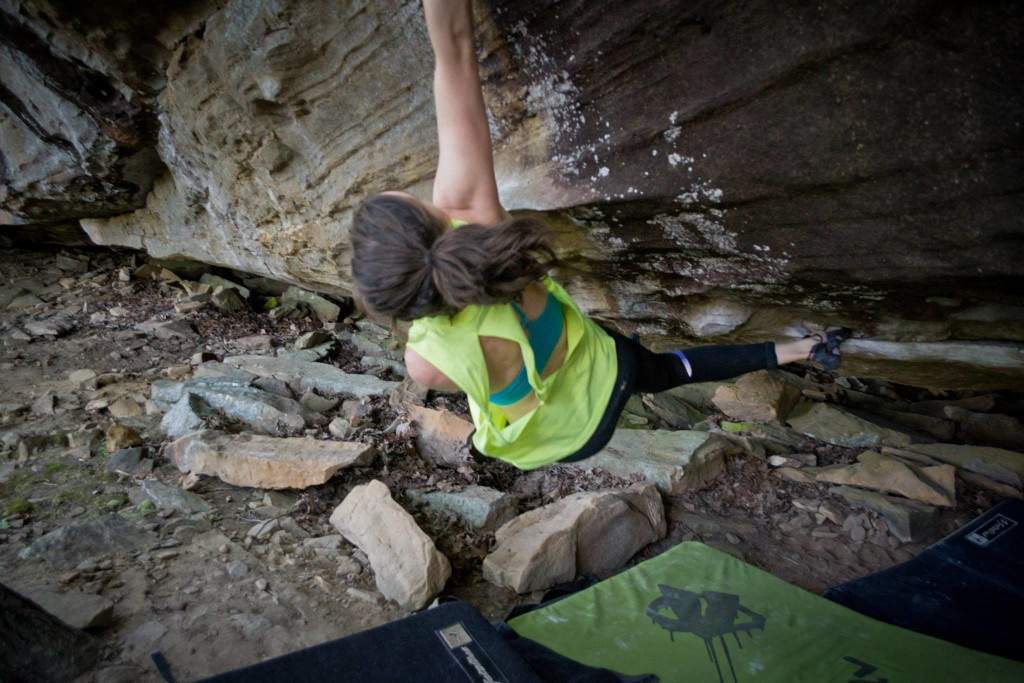
Focusing hard on digging in the right toe to keep from cutting my feet. (Photo credit: Jeline Guiles)
Nowadays I am constantly thinking about these little movements while climbing, and when I implement the 7 try rule I am putting out at least as much mental effort as physical effort.
Okay, so I just fell on that throw to the sloper (see above). Was it because I didn’t hit the hold at the right angle? Where should my center of gravity be when I hit the hold and how do I move to get my center of gravity exactly there? Do I need to focus more on engaging my core? Is my body too far away from the wall? Do I need to put more power into my jump? Clearly, there are a lot of questions to address to answer the simple question: why did I fall? That’s why you need 7 tries (at least) to fine-tune the movement.
So, what if I still can’t figure out this move?
Climbing Lesson #4: Ask for Help
As a beginner climber 5 years ago, I knew a couple of other beginner climbers, and we would all try to help each other out with tricky problems. Working out a climb with other people at your level can be one of the most fun parts of climbing. But, occasionally asking a more experienced climber for help on something that you just can’t figure out is a great resource for improvement. I feel really lucky to have learned to climb on a team where there was a coach and plenty of people stronger than me to help me work through tough moves and tell me what I needed to do to improve.
Even now, when I see someone cruising a move that I fell on I’ll ask them how they did it differently. And if I’m really struggling, I may ask someone to watch me and tell me what I’m doing wrong.
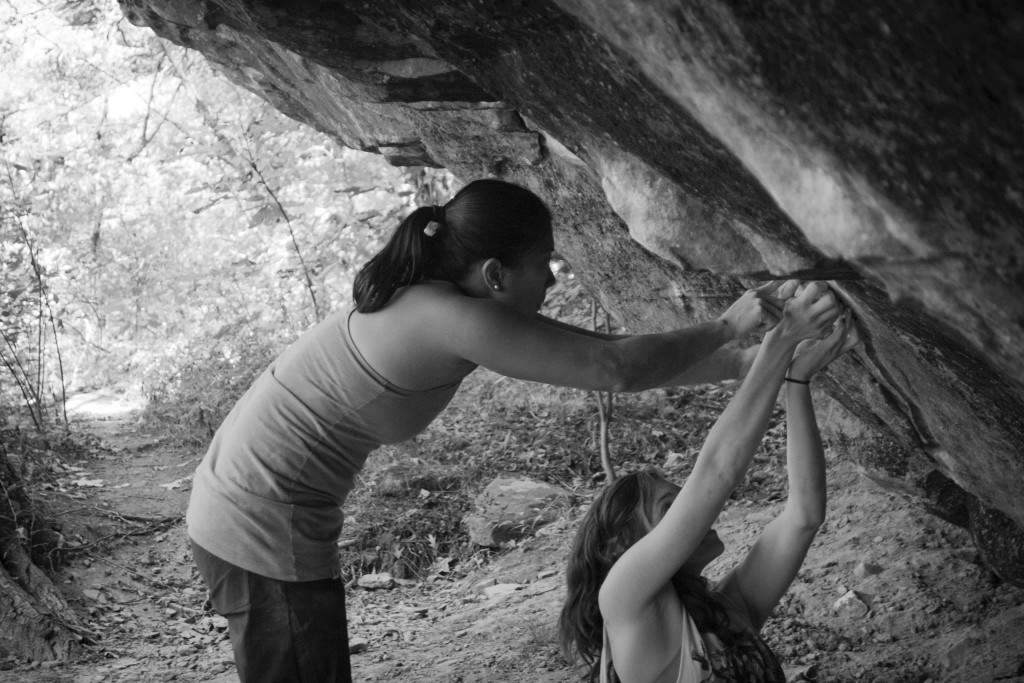
Asking Jeline (from Climb On, Sister) for some beta. (Photo credit: Jeline Guiles)
These days, I know many of the climbers at the gym, so I never feel embarrassed to ask for help. But when I was first getting started, I didn’t know that many people so I never felt comfortable asking one of the stronger climbers for advice. But to my younger self, I would encourage you to Just Ask!! If someone just cruised your project as their warm-up it’s okay to ask for advice.
Most climbers are willing to share their beta and help out a newbie. I have never asked for beta from a stranger and had someone turn up their nose at me and walk away. And when I get asked for advice from a new climber I’m usually flattered that think I’m strong enough to seek out beta from and always happy to help.
The last thing that I really struggled with, basically up until a year or two ago, was fear that other (stronger) climbers were watching me. So the last thing I would say is:
Climbing Lesson #5: Nobody is Watching You
Okay, that probably isn’t true. Often times people will watch you climb things at a gym. But if they’re really staring at you throughout your whole climb, it’s probably because they’re falling on that problem and want your beta. Everyone at the gym or the crag is there to hang out with friends and climb, just like you–no one is there just to people watch. Maybe someone sees you falling on your climb, but I can guarantee that they’re not sitting there laughing at your fall. Every strong climber knows what it’s like to be brand new, or projecting V2, V3, or V4.

Never forget to have fun while you climb! (Photo credit: Jeline Guiles)
I used to be terrified to climb my projects on a wall with other people that I didn’t know. But that fear was just plain crazy. Even if those unknown climbers were working on the hardest climb in the gym, that also happened to be on that wall, they were for sure not going to laugh at or criticize me for falling on my V4 project right next to their V10 project. Most likely they were focused on figuring out their own problem and were only looking at me on my project to know when they could safely get on the wall.
And one last little tip: if you’re working a project next to people who may seem (but are probably not) intimidating, it can help to make small talk with them about something unrelated to climbing, just to break the tension. And never forget to have fun!
Thanks Sarah for sharing your climbing lessons learned! Check out Sarah’s original post and more of her great tips, motivation, and amazing climbing trips on her blog: Climbing (Miss)Adventures.
Climb on! ~Cate




